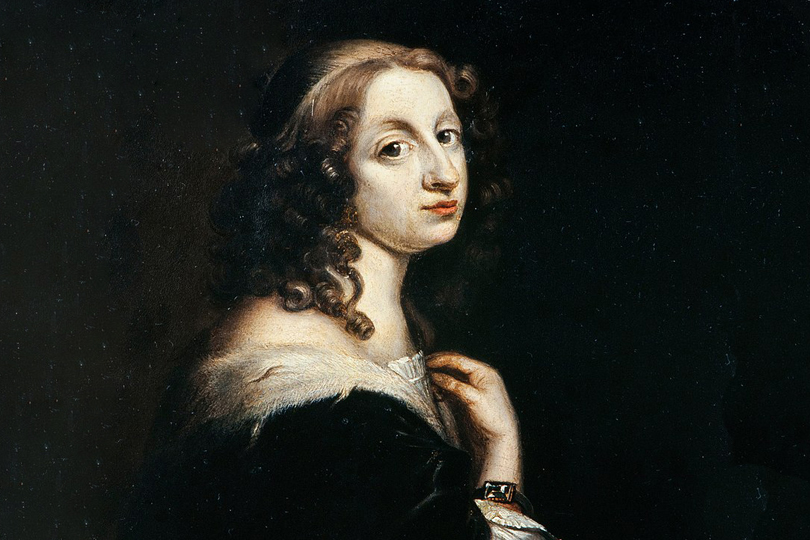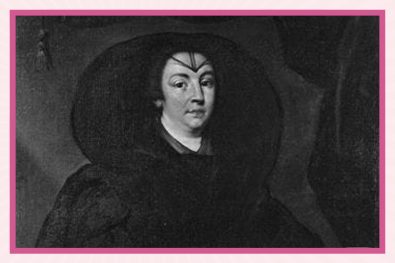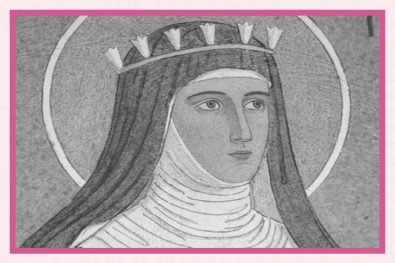In 1654, the reigning queen of Sweden shocked the world when she rode off in men’s clothing, leaving her crown behind. When Christina of Sweden shocked the world by abdicating her throne, she was known as one of the most powerful rulers of Europe, one of the most learned women of her age, a savvy and passionate patroness of the arts, and a stubborn queen who defied all expectations by refusing to marry and produce an heir. This was a woman who attracted equal parts admiration and scandal. Yet now, despite the fascinating story of her life, her name is relatively unknown in comparison with other early modern queens like Elizabeth I, Mary, Queen of Scots, and Catherine de Medici. Here, we look back at the life and legacy of Christina of Sweden.
Early Life
Christina (known as Kristina in Swedish) was born on December 18, 1626, as the only child of the great Swedish ruler, King Gustavus II Adolphus, and his wife Maria Eleonora of Brandenburg.
Just a few years after Christina’s birth, in 1630, Sweden became officially involved in the Thirty Years’ War. While this complex series of conflicts is a much larger story for another day, it is important to mention to understand the political context that Christina grew up in. According to historian Megan C. Armstrong, she was raised to rule from the start, as the undisputed heir presumptive, and her father often took Christina along with him to review the troops and she could be found by his side as he travelled across the nation.
Unfortunately, Gustavus was killed in battle in 1632, and so Christina inherited the throne at the young age of six years old. Luckily, her father left her in good hands, and a skilled regency council ruled in her name until she came of age, and the High Chancellor, Axel Oxenstierna, took charge of her education and made sure that her father’s wish that she be given a humanist education fit for a prince was fulfilled.
According to the Encyclopedia of World Biography, she was given a good grounding in history, philosophy, theology, and the sciences and was indeed educated “like a boy.” Christina became a master of French, German, Latin, Spanish, and Italian, and was confident in communicating with leaders around Europe and could appreciate and understand the important written works of the day.
Minerva of the North
When she was 14 years old, she started attending regency council meetings, and at the end of 1644, when Christina turned 18 years old, she officially took power and was crowned as Queen of Sweden.
She became known throughout Europe as the Minerva of the North for all her wit and support of learning. She began to lavishly patronize the arts, architecture, and intellectual projects. During her reign, the first Swedish newspaper emerged and education and learning flourished.
When she began her rule, she demonstrated astute political skills. Sweden still was the leading power of Protestant Europe, at war with the powers of Catholic Europe, but Christina helped bring an end to the Thirty Years War by “supporting a theological resolution that unified the Protestant religions.”
And yet, in the meantime, Christina was secretly corresponding with Catholic thinkers and becoming increasingly drawn to the “enemy” religion. She was impressed by famous philosophers like René Descartes and various priests who she received incognito at her court.
Unfortunately, Christina was extravagant and struggled financially throughout her reign. Her advisor Oxenstierna discouraged Christina’s spending, but she ignored his warnings of Sweden’s poor economic state, bringing the nation dangerously close to bankruptcy.
Rebel Queen
Marriage was always an important milestone for women of the early modern age, but for a queen, it was even more important. It was considered essential for queens to marry quickly and strategically, and to secure the line of succession by giving birth to an heir.
But just like the famous Queen Elizabeth I of England did a generation before, Christina defied this expectation and decided to remain single. Nevertheless, she continued to dangle the possibility of marriage in front of potential allies as a strategic ploy, keeping people guessing—and keeping them courting her, and therefore kind to her country.
In the meantime, rumours circulated that she was having an affair with her female friend, the Countess Ebba Sparre. It is also alleged that she had other female lovers throughout her life, and many modern biographers believe that she was a lesbian. She also caused quite a stir by dressing in masculine clothes and speaking freely without the reserve expected of women. Her sexual orientation and gender identity have been a point of interest to scholars, novelists, filmmakers, and others ever since.
In 1651, Christina completely shocked everyone when she announced to her parliament that she had decided to abdicate. Christina claimed that she was feeling ill, and the burden of ruling was “too heavy for a woman.” Statesmen managed to delay her from acting on this intention, but by 1654, she had her way and left Sweden, nominating her cousin as her successor.
First, Christina went to the Spanish Netherlands. She then travelled to Austria, where she added flames to the fire by announcing that she, former leader of the leading Protestant power of Sweden, had converted to Catholicism. After 30 years of Protestant Swedish-versus-Catholic Europe warfare, this was seen as not only absurd, but as an act of national betrayal.
Everyone wondered why she turned her life upside down and abdicated her throne, and the question remains unanswered. Theories from the personal to the political to religious have been put forward, but we’ll never know for sure.

Celebrity Salonnière
Christina travelled in style through Europe, increasing her notoriety as she went along. Finally, she arrived in Rome, where she would live for the rest of her life. She met with Pope Alexander VII, likely making his jaw drop when greeted him wearing a striking red dress, the colour typically associated with prostitutes.
Her home in Rome quickly became a hotspot for gatherings of important political and cultural leaders, and she hosted salons for intellectuals, noblemen, and cardinals alike to mingle and converse. Her palace boasted an incredible collection of paintings, sculptures, and other works of art. She also founded the Arcadia Academy, an Italian literary academy that still exists in Rome to this day, and she is credited with instigating the opening of the first opera house in Rome.
Christina was also known for her “militant protection of personal freedoms,” was involved in charitable projects, and became the “protectress of the Jews in Rome.”
Later Years and Legacy
She spent the rest of her life embroiled in political intrigues of Baroque Rome, making alliances with important statesmen. As Professor Dorota Gregorowicz writes, Christina had an “internal need to return to power.”
For example, she cultivated a relationship with the French Louis XIV’s chief minister Cardinal Mazarin. She tried to get her hands on the throne of Naples when she noticed its potential upcoming vacancy, through some shrewd political maneuverings. But her efforts came to nothing in the end, and only led to scandal when she ordered the brutal execution of her equerry for his betrayal.
She made a similar attempt to become queen of Poland, with her claim backed by her powerful friend the new Pope Clement IX, but that also ended in disappointment.
In the end, Christian died in 1689 as a queen without a realm, at the centre of political intrigue and intellectual discourse. Her tomb is in St. Peter’s Basilica in Rome, a rare honour.
Ever since, her reputation has been one of extremes: she has been praised by some and detested by others. Her home had been a leading intellectual salon for more than three decades, and she corresponded with the most important thinkers of the age. During her reign, she confounded her advisors time and time again. Her refusal to marry, her abdication, and her unpopular conversion were all ways that she pushed back on what was expected of her and demonstrated her determination to live by her own rules.












